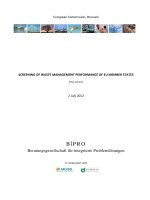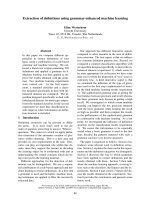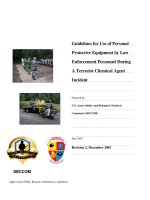Virtual screening of multi target agents by combinatorial machine learning methods
Bạn đang xem bản rút gọn của tài liệu. Xem và tải ngay bản đầy đủ của tài liệu tại đây (2.7 MB, 195 trang )
VIRTUAL SCREENING OF MULTI-TARGET
AGENTS BY
COMBINATORIAL MACHINE LEARNING
METHODS
SHI ZHE
(B.Sc, Shandong University)
A THESIS SUBMITTED
FOR THE DEGREE OF DOCTOR OF PHILOSOPHY
DEPARTMENT OF PHARMACY
NATIONAL UNIVERSITY OF SINGAPORE
2011
i
Acknowledgements
As Jiddu Krishnamurti once said "The whole of life, from the moment you are
born to the moment you die, is a process of learning." If there were any time when
I would appreciate this more than any other point in my life so far, I would say it
were the four-year PhD life of mine. The time I spent in National University of
Singapore (NUS) and Singapore during the pursuit of the PhD degree is a
precious gem in my life which has greatly expended the horizon of my minds
through the process of learning, both in academic and personal aspects.
This learning process would not have become this meaningful without the
encountering and interacting with the many wonderful people I have met during
the past four years. Even millions of sincere thanks would not be enough to count
for my gratefulness toward them.
First of all, I would like to express my foremost appreciation and thanks to Prof.
Chen Yuzong who has been a great mentor throughout my four-year studying and
research in NUS. He has been a very inspiring supervisor for my research work.
His enthusiasm and dedication to research, his insight in science discovery, his
critical thinking, his hard working spirit, and his humbleness has always been
enlightening to me. He has provided for me invaluable guidance in bioinformatics
and chemoinformatics research. I am especially grateful for his great patience and
efforts in cultivating a good environment for my growth in research area with
inspiring ideas and supervision. The great influence of him, however, is not
limited to research area. He is also a wise person with insightful understanding of
ii
life who is ever so willing to share with others the principles and disciplines in
life that can benefit a person to live a fulfilling life. I’d like to express my utmost
gratefulness to Prof Chen Yuzong and wish him the very best to his work and life.
My many thanks also go to the wonderful BIDD group members. It has been a
very pleasant time working with them. They have offered me great
companionship and inspiration not only on research but also on personal life. I
would like to thank each and every one of them for their collaboration and
company in the past four years. I would like to thank Ms Hai Lei and Ms Wang
Rong, even though they left BIDD not too long after I joined the group, for their
kindness as seniors. My very gratefulness goes to Ms Ma Xiaohua, Mr Zhufeng
and Ms Jia Jia. As seniors, they have been playing motivating role models for us
juniors to look up to. Ms Ma Xiaohua has been amazingly helpful and supportive
with my research work. She is quite knowledgeable and resourceful in
chemoinformatcs and is always so patient in answering and discussing research
questions. She tries her very best to help when someone turns to her. Ms Ma
Xiaohua is also a wonderful person with a big heart. She cares for us as her
friends. I couldn’t thank her more for her supportiveness and kindness. She is one
of the best persons one could have as a workmate and a friend. Ms Jia Jia is an
inspiring figure with a strong fighting spirit. Her courage and efforts in pursing
her goals in life has always inspired me. Mr Zhu Feng has been a wonderful
collaborator in research. His great attitudes toward research and his never ending
efforts to perfection in work have deeply impressed me to look up to. Meanwhile,
he presents a strong sense of team-work spirit which has made the collaborations
iii
with him both very pleasant and fruitful. Ms Liu Xin has always inspired me with
her great effort to present and make the best out of the tasks she has taken. I am
very honored to have been able to work with them and learned so many valuable
lessons from them. I would also like to thank my juniors, Ms Wei Xiaonai, Mr
Zhang Jingxian, Mr Han Bucong, Mr Tao Lin, Ms Qin Chu and Mr Zhang Cheng
for their assistance in research collaboration.
My learning process would not have been complete without the great lessons from
life itself outside the academic research. I have always felt so fortunate to have
met many wonderful and inspiring people from across the globe and become
friends with some awesome individuals. The landscapes of my minds have
become so much more extended and enlightened because of them. Their
companies have made my time in Singapore a wonderful and interesting
experience. To name a few, I would like to thank Ms Sit Wing Yee for her great
friendship. I really appreciate her supportiveness in times of need. My very
gratitude goes to Ms Laureline Josset, Ms Zhao Yangyang, Mr Zhang Yaoli, Mr
Maximilian Klement, Mr Evan Conover and Mr Michael Stratil for believing in
me and encouraging me to be who I am. I would also want to thank my awesome
rock climbing friends, to name a few, Mr Remi Trichet, Mr Michael Stratil, Mr
Siddharth Batra and Mr Hassan Arif. The climbing experiences with them have
made me strong in body and mind.
Last but not least, my utmost gratefulness goes to my wonderful parents and
families for their everlasting love and support. I could never thank my parents
iv
more for their love for me and their efforts in bringing the best out of me as a
person. To my beloved parents, I dedicate this thesis.
Shi Zhe
September 2011
v
Table of Contents
Acknowledgements i
Table of Contents v
Summary viii
List of Tables x
List of Figures xiii
List of Acronyms xvi
List of Publications xix
Chapter 1 Introduction 1
1.1 Pharmainformatics Database Development and Updates 2
1.2 Introduction to Virtual Screening in Drug Discovery 4
1.2.1 Structure-based and ligand based virtual screening 7
1.2.2 Conventional approaches of virtual screening methods 9
1.2.3 Machine learning methods for virtual screening 10
1.3 In-silico Approaches to Multi-target Drug Discovery 25
1.3.1 Introduction 25
1.3.2 Machine learning methods for searching multi-target agents 30
1.4 Objectives and Outline 33
Chapter 2 Methods 36
2.1 Data Collection and Processing 36
2.1.1 Analysis of data quality and diversity 38
2.1.2 Redundancy within the datasets 40
2.2 Molecular Descriptors 41
2.2.1 Definition and calculation of molecular descriptors 41
2.2.2 Scaling of molecular descriptors 45
2.3 Introduction to Machine Learning methods 46
2.3.1 Support vector machine (SVM) method 47
vi
2.3.2 K-nearest neighbor method (k-NN) 50
2.3.3 Probabilistic neural network method 52
2.3.4 Tanimoto similarity searching method 55
2.3.5 Generation of putative inactive compounds 55
2.4 Virtual Screening Model Validation and Performance Measurements 59
2.4.1 Model validation 59
2.4.2 Performance evaluation 60
2.4.3 Overfitting problem and its detection 62
2.5 Combinatorial Machine Learning Methods 62
Chapter 3 Pharmainformatics Database Construction and Update 65
3.1 The update of Kinetic Database of Bio-molecular Interaction 65
3.1.1 Introduction to bio-molecular interactions 65
3.1.2 New features of updated KDBI 66
3.1.2.1 New Feature 1: nucleic acid and pathway names as KDBI entries 66
3.1.2.2 New Feature 2: pathway simulation models 68
3.1.2.3 New Feature 3: multi-step processes of kinetic data 69
3.1.2.4 New Feature 3: SBML availability 71
3.2 Update of Therapeutic Targets Database 72
3.2.1 Target validation 73
3.2.2 QSAR models 75
3.2.3 Other update features 78
Chapter 4 Preliminary Tests of Combinatorial Machine Learning Methods in
Screening Multi-target Agents 80
4.1 Introduction: Multi-target Kinase Inhibitor Therapeutics for Cancer
Treatment 80
4.2 Materials and Methods 83
4.2.1 Compound collection, training and testing datasets, molecular descriptors 83
4.2.2 Computational methods 84
4.3 Results and Discussion 86
vii
4.3.1 Virtual screening performance of Combinatorial SVM in searching kinase
dual-inhibitors from large libraries 86
4.3.2 Analysis of combinatorial sVM identified MDDR virtual hits 91
4.4 Conclusion 93
Chapter 5 The Application of Combinatorial Machine Learning Methods in
Virtual Screening of Selective Multi-target Antidepressant Agents 94
5.1 Introduction 94
5.2 Materials and Methods 101
5.2.1 Data collection and molecular descriptors 101
5.2.2 Computational models 106
5.3 Results and Discussion 112
5.3.1 Individual target inhibitors and dual inhibitors of the studied target pairs 112
5.3.2 5-fold cross-validation tests of SVM, k-NN and PNN models 116
5.3.3 Virtual screening performance of Combinatorial SVM in searching multi-
target serotonin inhibitors from large compound libraries 122
5.3.4 Analysis of MDDR virtual hits of combinatorial SVM 132
5.3.5 Comparison of the performance of Combinatorial SVM with other virtual
screening methods 135
5.4 Conclusion 140
Chapter 6 Concluding Remarks 142
6.1 Major Findings and Merits 142
6.1.1 Merits of the updates of KDBI and TTD in facilitating multi-target drug
discovery 142
6.1.2 Findings of combinatorial machine learning methods for virtual screening in
the multi-target kinase inhibitors and antidepressant agents 145
6.2 Limitations and Suggestions for the Future Studies 149
BIBLIOGRAPHY 153
viii
Summary
Multi-target drugs have greatly attracted the attention and interest in drug
discovery. Efforts that explore experimental and in-silico methods have been and
are being made in search for the novel multi-target agents. As part of the
collective efforts for developing the tools to facilitate discovery multi-target
agents, I firstly participated in the updated the Kinetics database of bio-molecular
interactions (KDBI) and the Therapeutic targets database (TTD). The information
in the two databases can offer informative data in multi-target drug discovery.
Virtual screening (VS) is an increasingly used approach in the search for novel
lead compounds. It is capable of providing valuable contributions in hit and lead
compounds discovery. It has been intensively explored and various software tools
have been developed for the application of VS. It would be very interesting to
apply VS tools for the discovery of multi-target agents. However, many of the
conventional VS tools encounter the issues of the insufficient coverage of
compound diversity, high false positive, high false negative prediction and lower
speed in screening large libraries. These issues would hinder the practical
applications of conventional VS approaches in search of multi-target agents.
Therefore, in order to identify multi-target agents that are more sparsely
distributed in the chemical space than single-target agents, it is important to
address these issues and develop the methods that are capable of searching large
compound libraries at good yields and low false-hit rates.
ix
In this work, I explored a machine learning method, support vector machines
(SVM), to develop the combinatorial SVM (COMBI-SVM) VS tool for searching
dual-target agents for the treatment of cancers and major depression. COMBI-
SVMs models were preliminarily tested for searching dual-inhibitors of 4
combinations (EGFR-FGFR, EGFR-Src, VEGFR-Lck, and Src-Lck) of the 5
anticancer kinase targets (EGFR, VEGFR, Src, FGFR, Lck). COMBI-SVMs
produced comparable dual-inhibitor yields and significantly lower false-hit rates
for MDDR and PubChem dataset. There has been underpinning interest in
discovery and developing selective multi-target serotonin reuptake inhibitors
(SRIs) that can enhance antidepressant efficacy (1). The preliminary tests with the
4 kinase dual-inhibitors showed promising results and this encouraged me to
develop and test COMBI-SVMs for VS multi-target serotonin reuptake inhibitors
of 7 target pairs (serotonin transporter paired with noradrenaline transporter, H
3
receptor, 5-HT
1A
receptor, 5-HT
1B
receptor, 5-HT
2C
receptor, Melanocortin 4
receptor and Neurokinin 1 receptor respectively) from large compound libraries.
COMBI-SVMs showed moderate to good target selectivity in misidentifying
individual-target inhibitors of the same target pair and inhibitors of the other
target six pairs as dual-inhibitors; COMBI-SVMs also presented low dual-
inhibitor false-hit rates in screening large compound databases MDDR and
PubChem. Compared to the other three VS methods (similarity searching, k-NN
and PNN), it produced comparable dual-inhibitor yields, similar to or slightly
better target selectivity, and slightly to or substantially lower false-hit rate in
screening MDDR compounds.
x
List of Tables
Table 1-1 Instances of supervised machine learning methods 10
Table 1-2 Performance of machine learning methods in virtual screening test for
identifying inhibitors, agonists and substrates of proteins of pharmaceutical
relevance. 14
Table 1-3 Performance of docking methods in virtual screening test for
identifying inhibitors, agonists and substrates of proteins of pharmaceutical
relevance 19
Table 1-4 Performance of pharmacophore methods in virtual screening test for
identifying inhibitors, agonists and substrates of proteins of pharmaceutical
relevance. 22
Table 1-5 Performance of clustering methods in virtual screening test for
identifying inhibitors, agonists and substrates of proteins of pharmaceutical
relevance. 23
Table 2-1 Examples of small molecule databases available online 37
Table 2-2 Xue descriptor set 42
Table 2-3 98 molecular descriptors used in this work 44
Table 4-1 Datasets of dual-inhibitors and non-dual-inhibitors of the kinase-pairs
used for developing and testing combinatorial SVM virtual screening tools 82
Table 4-2 Virtual screening performance of combinatorial SVMs for identifying
dual-inhibitors of 4 combinations of EGFR, VEGFR,FGFR, Src and Lck 89
Table 4-3 MDDR classes that contain higher percentage (≥9%) of virtual-hits
identified by combinatorial SVMs in screening 168 thousand MDDR compounds
for dual-inhibitors of 4 combinations of EGFR, VEGFR, FGFR, Src and Lck 90
xi
Table 5-1 Datasets of individual-target inhibitors, dual inhibitors and MDDR
compounds similar to at least one dual inhibitor used as the training and
testingsets in this work 104
Table 5-2 5-fold cross-validation of SVM models for parameter selection and
additional tests of these models for predicting dual-inhibitors and non-inhibitors
108
Table 5-3 Distribution of the top-ranked scaffolds in multi-target inhibitors of the
7 target pairs SERT-NET, SERT-H
3
, SERT-5HT
1A
, SERT-5HT
1B
, SERT-5HT
2C
,
SERT-MC
4
and SERT-NK
1
115
Table 5-4 5-fold cross-validation of k-NN models for parameter selection and
additional tests of these models for predicting dual-inhibitors and non-inhibitors
117
Table 5-5 5-fold cross-validation of PNN models for parameter selection and
additional tests of these models for predicting dual-inhibitors and non-inhibitors
120
Table 5-6 The virtual screening performance of combinatorial SVMs for
identifying multi-target serotonin inhibitors of the seven target pairs SERT-NET,
SERT-H3, SERT-5HT1A, SERT-5HT1B, SERT-5HT2C, SERT-MC4 and SERT-
NK1; 127
Table 5-7 MDDR classes in which higher percentage (≥5%) of COMBI-SVM
identified MDDR multi-target virtual hits are distributed in 128
Table 5-8 Comparison of the performance of combinatorial SVMs with other
virtual screening methods for identifying multi-target inhibitors of the four target
pairs 139
xii
Table 6-1 The data statistics of the updated Target Therapeutic Database 145
Table 6-2 Target pair (sequence identity) and the false hit rate for inhibitor pairs
and their dual inhibitor yields 148
xiii
List of Figures
Figure 1-1 Typical numbers of compounds available in the chemical space 5
Figure 1-2 General procedure used in SBVS and LBVS (adopted from Rafael
V.C. et al(15)). 6
Figure 1-3 Molecular docking strategy for multi-target inhibitor discovery 27
Figure 1-4 Combined pharmacophore and molecular docking strategy of multi-
target inhibitor discovery 27
Figure 1-5 Illustration of framework combination approach to multi-target drug
discovery 28
Figure 1-6 Illustration of fragment-based approach to multi-target drug discovery
28
Figure 1-7 Work flow for detecting multi-target agents by machine learning (ML)
methods; Structure-activity data are collected by literature mining. Then the ML
method is applied to build a screening model which will be used to scan the
compound database (e.g. PubChem); After the screening, positive dual-inhibitors
will be selected for further synthesis and test. If they prove to have promising
pharmacological profiles, they can be used into the training data for new
predictions. 32
Figure 2-1 Schematic diagram illustrating the process of the training a prediction
model and using it for predicting active compounds of a compound class from
their structurally-derived properties (molecular descriptors) by using support
vector machines; A, B, E, F and (hj, pj, vj,…) represents such structural and
physicochemical properties as hydrophobicity, volume, polarizability, etc. 49
xiv
Figure 2-2 Schematic diagram illustrating the process of the prediction of
compounds of a particular property from their structure by using a machine
learning method – k-nearest neighbors (k-NN). A, B: feature vectors of agents
with the property; E, F: feature vectors of agents without the property; feature
vector (hj, pj, vj,…) represents such structural and physicochemical properties as
hydrophobicity, volume, polarizability, etc. 51
Figure 2-3 Schematic diagram illustrating the process of the prediction of the
compounds of a particular property from their structure by using a machine
learning method –probabilistic neural networks (PNN). 54
Figure 3-1: Experimental kinetic data page showing protein–protein interaction 67
Figure 3-2 This page provides kinetic data and reaction equation (when available)
as well as the name of participating molecules and description of event in the
pathway simulation models 69
Figure 3-3 Multi-process kinetic data page provides kinetic data and reaction
equation (when available) as well as the name of participating molecules and
description of event 70
Figure 3-4 The circled part is linked to where the SBML format data are offered.
This link is presented in every query result page. 71
Figure 3-5 An example for target validation information presented in the updated
TTD 75
Figure 3-6 The QSAR model search page offers search by target and search by
chemical type 77
Figure 3-7 An example of the search page for QSAR models. Detailed description
of QSAR models can be downloaded via the link “QSAR model page” 77
xv
Figure 3-8, Figure 3-9, Figure 3-10 Downloading pages for multi-target agents,
Drug combination information and Nature-derived drugs 79
Figure 4-1 Illustration of combinatorial support vector machines method
(COMBI-SVM) for searching multi-target inhibitors for searching multi-target
inhibitors 85
Figure 5-1 Examples of multi-target multi-target serotonin reuptake inhibitors 100
Figure 5-2 The Venn graph of the collected 7 evaluated dual-inhibitors pairs and
non-dual-inhibitors of the 8 evaluated targets 105
Figure 5-3 The COMBI-SVMs diagram 111
Figure 5-4 Top-ranked molecular scaffolds primarily found in known multi-target
serotonin reuptake inhibitors 114
xvi
List of Acronyms
5HT1aAntags
5-HT
1A
receptor antagonists
5HT1aSRIs
Dual serotonin reuptake inhibitor and 5-HT
1A
receptor
antagonists
5HT1bAntags
and 5-HT
1B
receptor antagonists
5HT1bSRIs
Dual serotonin reuptake inhibitor and 5-HT
1B
receptor
antagonists
5HT2cAntags
5-HT
2C
receptor antagonists
5HT2cSRIs
Dual serotonin reuptake inhibitor and 5-HT
2C
receptor
antagonists
CNS
Central nervous system
COMBI-SVM
Combinatorial support vector machines
DI
Diversity index
EGFR
Epidermal growth factor receptor
FDA
The Food and Drug Administration
FGFR
Fibroblast Growth Factor Receptor
FN
False negative
FP
False positive
H3Antags
H
3
receptor antagonists
H3SRIs
Dual serotonin reuptake inhibitor and H
3
receptor
antagonists
HTS
High throughput screening
KDBI
Kinetics database of biomolecular interactions
xvii
k-NN
k-nearest neighbors
LBVS
Ligand-based Virtual Screening
Lck
Lymphocyte-specific protein tyrosine kinase
MC
4
Melanocortin 4
MC4Antags
MC
4
receptor antagonists
MC4SRIs
Dual serotonin reuptake inhibitor and MC
4
receptor
antagonists
MCC
Matthews correlation coefficient
MDDR
MDL Drug Data Report
ML
Machine Learning
NCEs
Novel chemical entities
NET
Noradrenaline transporter
NETSRI
Dual serotonin reuptake and noradrenaline reuptake
inhibitors
NK
1
Neurokinin 1
NK1Antags
NK
1
receptor antagonists
NK1SRIs
Dual serotonin reuptake inhibitor and NK
1
receptor
antagonists
NRIs
Noradrenaline reuptake inhibitors
PNN
Probabilistic neural network
QSAR
Quantitative structure activity relationship
SAR
Structure-activity relationship
SERT
Serotonin transporter
SBML
System Biology Markup Language
xviii
SBVS
Structure-based Virtual Screening
SRI
Serotonin reuptake inhibitor
SSNI
Serotonin/noradrenaline reuptake inhibitor
SSRI
Serotonin reuptake inhibitor
SVM
Support vector machine
TN
True negative
TP
True positive
TK
Tyrosine kinase
TKI
Tyrosine kinase inhibitor
TTD
Therapeutic targets database
VEGFR
Vascular endothelial growth factor receptor
VS
Virtual Screening
xix
List of Publications
1. Combinatorial Support Vector Machines Approach for Virtual Screening of
Selective Multi-Target Serotonin Reuptake Inhibitors from Large Compound
Libraries. Z.Shi, X.H.Ma, C.Qin, J.Jia, Y.Y.Jiang, C.Y.Tan, Y.Z.Chen. Journal
of Molecular Graphics and Modelling. (Impact Factor: 2.033 ) Accepted, (2011).
2. Clustered patterns of species origins of nature-derived drugs and clues for
future bioprospecting. F. Zhu, C. Qin, L. Tao, X. Liu, Z. Shi, X.H. Ma, J. Jia, Y.
Tan, C. Cui, J.S. Lin, C.Y. Tan, Y.Y. Jiang and Y.Z. Chen. PNAS. (Impact
Factor: 9.771) 108(31):12943-8 (2011).
3. Therapeutic Target Database Update 2012: A Resource for Facilitating Target-
Oriented Drug Discovery. Zhu, Feng; Shi, Zhe; Qin, Chu; Tao, Lin; han, bucong
,; Zhang, Peng; Chen, Yuzong. Nucleic Acids Res. Submitted (Impact factor:
7.836) (2011) (submitted)
4. In-Silico Approaches to Multi-Target Drug Discovery. H.X. Ma, Z. Shi, C.Y.
Tan, Y.Y. Jiang, M.L. Go, B.C. Low and Y.Z. Chen.Pharm Res.(Impact factor:
4.456) 27(5):2101-10 (2010).
5. Update of KDBI: Kinetic Data of Bio-molecular Interaction Database. P.
Kumar, Z.L. Ji, B.C. Han, Z. Shi, J. Jia, Y.P, Wang, Y.T. Zhang, L. Liang, and Y.
Z. Chen. Nucleic Acids Res. 37(Database issue): D636-41(2009).
Chapter 1 Introduction 1
Chapter 1 Introduction
Considerable efforts have been put into drug design; however, the number of
successful drugs did not increase appreciably during the past decade. Recent
evidence suggests that the main causes of failure of compounds in the clinic are
lack of efficacy and poor safety. Agents that modulate multiple targets
simultaneously have the potential to enhance efficacy or improve safety relative to
drugs that modulate only a single target. As a result, multi-target agents have
been gaining increasing interest of researchers and drug discovery teams. To
assist the research of multi-target discovery, I participated in the further
development of two pharmainformatics databases, i.e., the update of KDBI and
BIDD. As a complementary approach to the traditional chemical and biological
methods, virtual screening has aroused increasing attention in the
pharmaceutical industry as a productive and cost-effective technology (2).
Various computational screening tools, such as docking, quantitative structure
activity relationship (QSAR), support vector machines (SVM), k-NN, PNN etc, are
being developed and refined to effectively employ fast screening methods to yield
potent lead hits. In my work, the combinatorial SVM (COMBI-SVM) virtual
screening (VS) tool was developed for searching multi-target agents. This method
was firstly tested with four anticancer kinase target pairs and then was applied to
seven antidepressants target pairs. Compared with the other three VS methods,
i.e., similarity searching, k-NN and PNN, COMBI-SVM produced comparable
dual-inhibitor yields, similar to or slightly better target selectivity, and slightly to
or substantially lower false-hit rate in screening MDDR compounds.
Chapter 1 Introduction 2
The following sections present a brief introduction to development of
pharmainformatics databases (Section 1.1), an overview of methods in virtual
screening (Section 1.2) and in-silico approaches to multi-target drug discovery
(Section 1.3). In addition, the outline of this thesis (Section 1.4) is introduced.
1.1 Pharmainformatics Database Development and Updates
With the exponential increase in pharma-information, it is becoming increasingly
necessary and important to collect and curate the information to provide
informative sources to effectively assist the studies of disease mechanisms and
the discovery of new drugs. Pharmainformatics databases can provide up-to-date
information and data that relate to disease mechanism studies, pharmaceutical
research and drug development. They offer various types of information for a
number of interdisciplinary areas such as bioinformatics, chemoinformatics, drug
data, bioactive compound data, interaction and kinetics data, in- silico ADME-
Tox prediction and molecular modeling.
The process of a database construction consists of two major steps. The first step
is data collection and quality control. The quantity and quality of the data are
decisive to the usefulness and popularity of a database. The second step involves
database interface design and maintenance. Well-designed databases usually share
the following qualities: informative with a clear presentation; user-friendly with
easy manipulation; fast and accurate search within the database; Continuous
Chapter 1 Introduction 3
updates with new information, data and other features. Additional qualities
include data download, inter links to other related databases and data processing
functions for the personalized data.
In this work, I participated in the update of the Kinetics database of bio-
molecular interactions (KDBI) (3)
and the Therapeutic targets database (TTD) (4).
KDBI stores the kinetic information of bio-molecular interactions. This
information is essential for quantitative studies of the interactions between bio-
molecules of a given bio-system (3). Numerous improvements and updates
have been added to KDBI, including new ways to access data by pathway
and molecule names, data file in System Biology Markup Language (SBML)
format. It can accommodate the increasing data demand in quantitative system
biology studies which play an important role in understanding the mechanisms
underlying many complex diseases.
TTD has been developed to provide comprehensive information about the known
targets and the corresponding approved, clinical trial and investigative drugs.
Since its last update in 2010, major improvements and updates have been made to
TTD. These updates include a significant increase of data content, target
validation information and quantitative structure activity relationship (QSAR)
models.
Chapter 1 Introduction 4
1.2 Introduction to Virtual Screening in Drug Discovery
Traditionally, the progress in drug discovery has been made by a combination of
random screening and rational design (5). Given the mounting competiveness of
pharmaceutical industry, high throughput screening (HTS) has become a key tool
in many pharmaceutical companies for its ability to test vast number of
compounds quickly and efficiently. However, HTS offers no guarantee of success
and over-reliance on random HTS are showing apparent problems. Additionally,
establishing a robust assay is very costly: a single HTS programme without assay
development could still cost approximately US $75,000 (6). Moreover, collections
of synthesized compounds or natural products can only represent a limited space
in the entire drug-like chemical space. The typical screening collection of a large
pharmaceutical company is of the order of a few million compounds at most. This
is a tiny fraction of the huge chemical space (7, 8), which is many orders of
magnitude larger than this, even if only drug-like compounds are considered (9).
Given these caveats, it is worth evaluating other technologies that may
complement HTS assay and synthesis. The term 'virtual screening' first came into
being in 1997; it has been used to describe a process of computationally analyzing
large compound collections in order to prioritize compounds for synthesis or
assay. During the last decade, a broad range of computational techniques have
been applied to search for novel bioactive compounds for many targets. VS
method does not require the physically synthesized compound libraries such
greatly recedes the cost. This also potentially extends the exploration of the
chemical space outside the in-house compound pools. There are around 10 million
Chapter 1 Introduction 5
commercially available compounds that can be exploited with the VS approach.
On top of it, virtual combinatorial libraries contain at least 1 million-fold larger
libraries than those available for HTS. This adds a new dimension to the VS
search space (Figure 1-1).
Figure 1-1 Typical numbers of compounds available in the chemical space
Based on the requirement of either the structure of a target or its ligands, virtual
screening methods can be often classified into structure-based virtual screening
(SBVS) and ligand-based virtual screening (LBVS) (10). SBVS consists of the
virtual docking of candidate ligands into a protein target followed by the
estimation of the probability of the high affinity binding between them calculated
by a scoring function (11, 12). LBVS methods, such as pharmacophore methods
(13) and chemical similarity analysis methods (14), require the ligand structure
information, they focus on discoverying the new drug hits by analyzing the
physical and chemical similarities of known compound pools by computational









